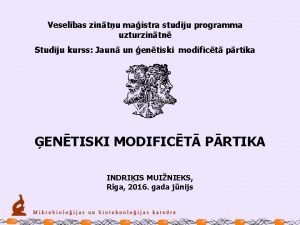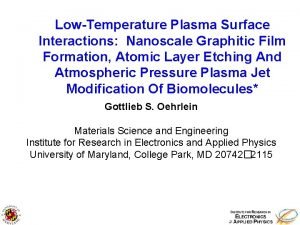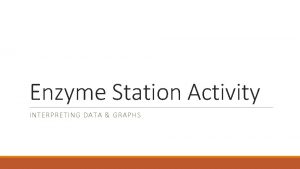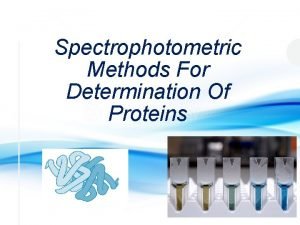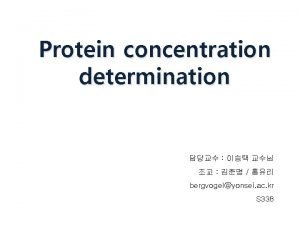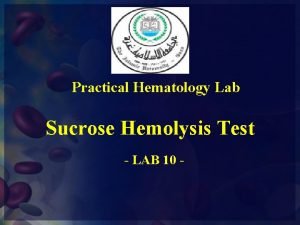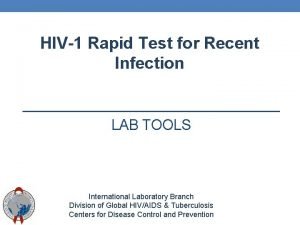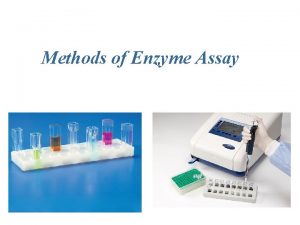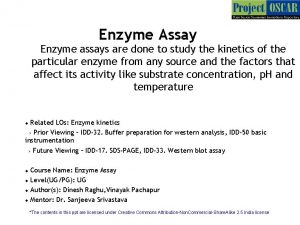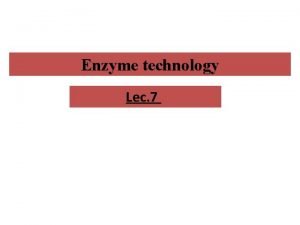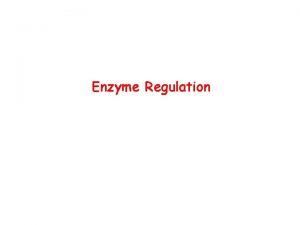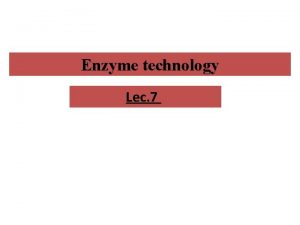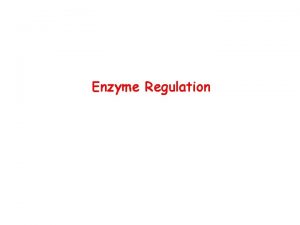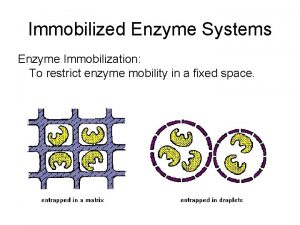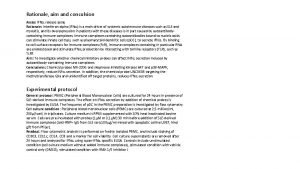Enzyme Assay Why and How Introduction In most





![Initial velocity • dp/dt = [ES]k 2 … no backward reaction • Total enzyme Initial velocity • dp/dt = [ES]k 2 … no backward reaction • Total enzyme](https://slidetodoc.com/presentation_image/4f85a6bc9dc358794fdb2a794274e5bc/image-6.jpg)





- Slides: 11

Enzyme Assay Why and How? ?

Introduction • In most cases, actual molar enzyme concentration is not known. We measure amount of enzyme by its activity in terms of enzyme unit of rate or a IU. • IU is also a way to monitor the enzyme purification. • In our study the enzyme activity we measure is more related to amount of enzyme rather than its physiological situation.

IU • One IU is defined as the amount of enzyme that produces a μmole product per minute under defined conditions. • The concentration of enzyme is expressed as IU/m. L • The specific activity (SA) is the number of IU per mg protein. – As the enzyme is purified the SA increases

Classical Chemical Kinetics • Classical kinetic theory answers the question “what determines the rate of formation or destruction of any given compound? ” » k 1 • A + B → C +D » K-1 • The rate of formation of one compound (lets say C) at any time (d. C/dt) is proportional to the concentration of the reactants (A, B) and the rate constant (k 1). • Formation of

Enzyme Kinetics • Recent methods invovle enzyme-substrate complex formation Enzyme + Substrate → Enzyme substrate Complex → Enzyme + Product Michaelis-Menten Equation Vo = Vmax[S] / Km – [S] Vo = initial reaction ; [S] = substrate concentration; km affinity between enzyme and substrate Initial stages of reaction is dependent on substrate concentration and is the fastest reaction at any given enzyme concentrations
![Initial velocity dpdt ESk 2 no backward reaction Total enzyme Initial velocity • dp/dt = [ES]k 2 … no backward reaction • Total enzyme](https://slidetodoc.com/presentation_image/4f85a6bc9dc358794fdb2a794274e5bc/image-6.jpg)
Initial velocity • dp/dt = [ES]k 2 … no backward reaction • Total enzyme [Enztotal] = [Enzfree] + [ES] • The first assumption is true only for initial stages of reaction. • Vo - Fastest and dependent on substrate concentration. • ES ~ E total • Vo =[Enzyme]k 2 = Vmax

Initial reactions • If we have excess substrate , initial velocity is always a function of the total enzyme. • Vo will be different at different enzyme concentrations. • If we plot Vo versus time, one should get straight line.


The effect of enzyme concentration on initial reaction velocity (v 0)

Enzyme activity • Protein assay: to get total protein (crude to pure there will be a decrease in enzyme – non-enzyme protein ratio) • IU by using initial velocities • G 3 P + NAD + i. P → 1, 3 BPG + NADH + H+ • The kinetics follows rapid equilibrium random bi bi mechanism. The reaction is first order in the total amount of enzyme.

Measuring the product • Formation of NADH. • Method 1: Generate G 3 P by mixing FDP and aldolase which then under goes the rxn • Method 2: Use commercial G 3 P (expensive and unstable)
 Enzyme-linked immunosorbent assay (elisa)
Enzyme-linked immunosorbent assay (elisa) Enzyme-linked immunosorbent assay (elisa)
Enzyme-linked immunosorbent assay (elisa) Enzyme-linked immunosorbent assay (elisa)
Enzyme-linked immunosorbent assay (elisa) Hey bye bye
Hey bye bye What variables affect enzyme activity in each of the graphs
What variables affect enzyme activity in each of the graphs Dont ask why why why
Dont ask why why why Warburg christian method protein concentration
Warburg christian method protein concentration Quanshun zhang
Quanshun zhang Bca assay 원리
Bca assay 원리 Hemolysis assay
Hemolysis assay Asante hiv-1 rapid recency assay
Asante hiv-1 rapid recency assay Describe the principle for the assay of ibuprofen
Describe the principle for the assay of ibuprofen
